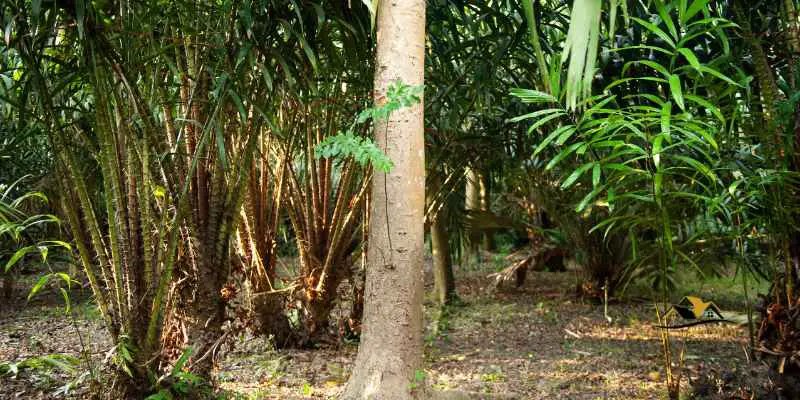To grow Agarwood, use seeds from older mother trees and plant them in a suitable environment. Agarwood, also known as Oud, is a highly valued and prized aromatic wood, celebrated for its use in fragrance and medicinal applications.
With a growing demand for Agarwood, cultivating these trees is gaining attention globally. Agarwood tree cultivation requires specific conditions, and understanding the process is crucial for a successful harvest. In this comprehensive guide, we will delve into the essential aspects of Agarwood cultivation, including the ideal conditions for growth, the propagation process, and the potential benefits of growing Agarwood trees.
Whether you are a novice grower or an experienced farmer, this guide will provide valuable insights into the intricacies of cultivating this precious and sought-after tree.
Why Agarwood Is Valuable
Agarwood, also known as oud, is highly valuable due to its unique and aromatic qualities. To grow agarwood, one can use seeds from older mother trees and follow expert tips such as collecting healthy seeds, soaking them in fungicide, and planting them in the right conditions.
Its demand and profitability make agarwood a sought-after plant for cultivation.
Illegal Status And Conservation Efforts
The illegal status of agarwood stems from the endangered status of the Aquilaria species, making unauthorized harvesting and trading prohibited to protect its sustainability. Conservation efforts aim to promote responsible cultivation and utilization to preserve this precious resource.
Cost And Demand In The Market
The high cost of agarwood is driven by its scarcity and increasing global demand across perfumery, medicinal, and religious sectors. This sought-after commodity commands premium prices due to its exquisite aroma and limited availability.
Growing Agarwood
Agarwood, also known as Oud, is a highly valuable and aromatic resin produced by the Aquilaria tree. Cultivating Agarwood requires specific techniques to ensure the production of high-quality resin. Let’s delve into the essential aspects of Growing Agarwood, including seed selection, planting, inoculation process, and tips for successful farming.
Seed Selection And Planting
For successful Agarwood cultivation, it is crucial to select seeds from older mother trees. These seeds possess the genetic traits needed for high-quality resin production. Once selected, the seeds should be sown in well-draining soil with adequate sunlight and moisture. This process sets the foundation for the growth of healthy Agarwood trees.
Inoculation Process For Agarwood
The inoculation process is a pivotal step in Agarwood farming to induce resin formation. It involves the careful piercing of the tree’s heartwood with specific fungi or bacteria. This stimulates the tree’s defense mechanism, leading to the formation of Agarwood resin. The selection of the appropriate inoculation method and timing is critical for maximizing resin production.
Tips For Successful Agarwood Farming
- Ensure proper care and maintenance of Agarwood trees by providing necessary nutrients and regular watering.
- Monitor the health of the trees and address any pest or disease issues promptly.
- Implement sustainable farming practices to preserve the natural habitat of Agarwood trees.
By following these tips, farmers can optimize the Agarwood cultivation process and contribute to the sustainable production of this precious resin.
Agarwood Growth Factors
Agarwood growth factors include suitable climate, soil, and Agarwood tree planting techniques. To grow Agarwood, use seeds from established trees, ensuring proper care and maintenance for healthy growth. Additionally, seek expert guidance to maximize the tree’s potential.
Climate Requirements
When it comes to cultivating agarwood, it’s essential to consider the climate requirements. Agarwood trees thrive in tropical and subtropical regions with high humidity and rainfall. They prefer temperatures ranging from 25 to 35 degrees Celsius (77 to 95 degrees Fahrenheit). Extreme temperature fluctuations can negatively impact the growth and resin production of agarwood trees.
If you are planning to grow agarwood in your garden, make sure to choose a location with a warm and humid climate. Areas such as Southeast Asia, India, Indonesia, Malaysia, and Thailand are known to provide suitable climate conditions for agarwood cultivation.
Soil Conditions And Fertilization
The soil conditions play a crucial role in the successful growth of agarwood trees. Agarwood requires well-draining soil with a pH range of 6.0 to 6.8. The soil should be rich in organic matter to provide the necessary nutrients for the tree’s growth. Before planting agarwood seeds or seedlings, ensure that the soil is properly prepared.
It is recommended to incorporate organic compost or well-rotted manure into the soil to improve its fertility. This will help provide essential nutrients and promote healthy root development. Additionally, adding a layer of mulch around the tree’s base will help retain moisture and suppress weed growth.
Fertilization is another important aspect of agarwood cultivation. Applying a balanced fertilizer with a ratio of 10-10-10 or 14-14-14 during the growing season can boost the tree’s growth and resin production. However, excessive use of fertilizers should be avoided as it can lead to nutrient imbalances and negatively affect the tree’s health.
Regular soil testing can help determine the nutrient requirements of the agarwood tree and guide the appropriate fertilizer application. It is always advisable to consult with a local horticulturist or agricultural expert to ensure the right fertilizer dosage and schedule based on your specific soil conditions.
Agarwood Harvesting And Processing
Agarwood is a highly valued and sought-after product due to its aromatic resin, making it a profitable venture for growers. Understanding the efficient harvesting and processing techniques for Agarwood is essential to maximize its potential benefits.
The Harvesting Process
The harvesting of Agarwood begins with identifying mature trees, typically around 7-10 years old, before implementing sustainable extraction methods to preserve the trees and promote regrowth.
Agarwood Extraction Techniques
There are various extraction techniques, such as traditional methods involving the natural formation of resin within the tree, as well as newer inoculation techniques that stimulate resin production. These techniques aim to ensure a sustainable and ethical approach to Agarwood extraction.
Market Value And Profitability
Agarwood’s high demand and limited availability contribute to its significant market value and profitability. By understanding the market dynamics and investing in quality extraction and processing, growers can capitalize on the lucrative Agarwood industry.
Agarwood Cultivation Around The World

Agarwood, also known as oud, is a highly valued and sought-after aromatic wood that is mainly used in the production of perfumes, incense, and medicinal products. The cultivation of agarwood has been practiced for centuries in various countries around the world. Let’s explore the leading countries in agarwood production and the global impact of agarwood farming.
Leading Countries In Agarwood Production
Agarwood is primarily cultivated in several countries due to favorable climatic conditions and a long history of expertise in the field. Some of the leading countries in agarwood production include:
- Vietnam: Vietnam is renowned for producing the best quality agarwood, also known as “Oud,” in the world. The country’s unique climatic conditions and abundant old-growth forests provide an ideal environment for agarwood trees to thrive.
- Thailand: Thailand is another significant producer of agarwood, particularly in the southern regions. The agarwood from Thailand is highly regarded for its rich aroma and exceptional quality.
- Malaysia: Malaysia has a long-standing tradition of agarwood cultivation, especially in the states of Peninsular Malaysia and Sabah. The country’s tropical rainforests offer the perfect conditions for agarwood trees to develop their distinctive resin.
- India: In India, agarwood is primarily cultivated in the states of Assam, Manipur, and Nagaland. The region’s diverse flora and tropical climate contribute to the growth of agarwood trees, making it a significant player in agarwood production.
- Cambodia: Cambodia has recently emerged as a major player in the agarwood industry. The country’s vast forest resources and suitable climate have led to a surge in agarwood cultivation and production.
Global Impact Of Agarwood Farming
The cultivation of agarwood has a significant global impact in various aspects, including the economy, environment, and cultural heritage. Here are some key points highlighting the global impact of agarwood farming:
- Economic Contribution: Agarwood cultivation and the associated industries contribute significantly to the economies of producing countries. It provides employment opportunities and generates revenue through the export of agarwood products.
- Conservation Efforts: Agarwood farming promotes the conservation of forests and biodiversity. Sustainable cultivation practices ensure the protection of agarwood trees and their habitats, thus preserving valuable ecosystems.
- Poverty Alleviation: Agarwood cultivation empowers local communities by providing them with a sustainable source of income. This helps alleviate poverty and improves the livelihoods of those involved in the industry.
- Cultural Significance: Agarwood has deep cultural and religious significance in many societies. It is used in traditional ceremonies, religious rituals, and as an offering. Agarwood farming helps preserve cultural heritage and traditions.
- Medicinal Uses: Agarwood is highly valued in traditional medicine for its various therapeutic properties. It is used to treat a range of ailments, including digestive issues, respiratory problems, and stress-related disorders.
- Sustainable Practices: With the increasing demand for agarwood, there is a growing emphasis on sustainable farming practices. This includes responsible harvesting, proper tree management, and the promotion of plantation cultivation.
Overall, agarwood cultivation plays a vital role in the global market, environmental conservation, cultural heritage, and sustainable development.
Challenges And Risks In Agarwood Farming
Agarwood farming presents Regulatory Issues and Legal Concerns that need careful consideration to avoid potential pitfalls.
Regulatory Issues And Legal Concerns
- Laws governing Agarwood farming vary, with some regions requiring permits and regulations.
- Harvesting, possession, and trade of Agarwood derived from the wild may be illegal in certain areas.
- Efforts are being made to protect Aquilaria species and ensure sustainable use of Agarwood.
Environmental Impact And Sustainability
- Agarwood farming can have environmental implications, impacting biodiversity and ecosystems.
- It is crucial to cultivate Agarwood sustainably to preserve natural resources for future generations.
Considering the Environmental Impact and Sustainability of Agarwood farming is essential for long-term success and ecological balance.
Future Of Agarwood Farming
The future of Agarwood farming holds great promise as the demand for this valuable resource continues to rise globally. Innovations in cultivation techniques and sustainable practices are driving the industry towards a prosperous future.
Innovation In Agarwood Cultivation
Innovative methods in Agarwood cultivation are revolutionizing the way this precious commodity is produced.
Economic Opportunities For Growers
Economic opportunities for Agarwood growers are expanding, offering a lucrative avenue for agricultural entrepreneurship.
Frequently Asked Questions
Why Is Agarwood Illegal?
Agarwood is illegal due to its status as a threatened species. Harvesting, possession, and trade without permits are prohibited to protect it sustainably.
Why Is Agarwood So Expensive?
Agarwood is expensive due to its rarity and the labor-intensive process of harvesting.
What Is The Lifespan Of Agarwood?
The lifespan of agarwood is around 30-40 years, but some trees can live up to 100 years.
Which Country Produce Most Agarwood?
Vietnam produces the most agarwood.
Conclusion
When looking to start agarwood cultivation, it is essential to understand the legality and regulations concerning its growth. Also, acknowledging its growth process, demand, and profitability constitutes a wise move. With careful planning and adherence to environmental and legal standards, it is possible to achieve a successful agarwood farming operation.


